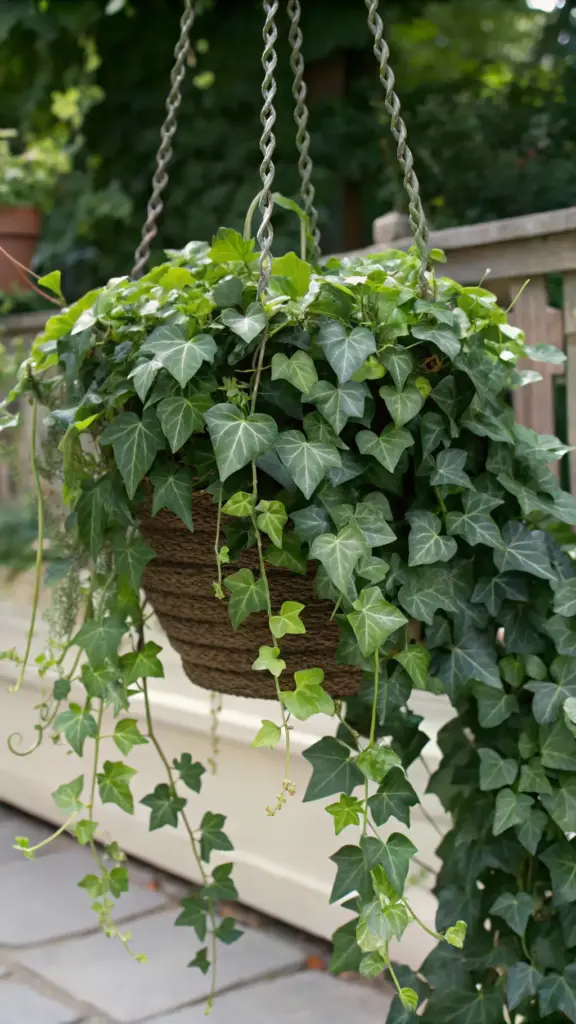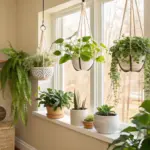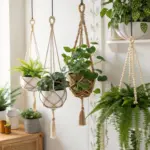7. English Ivy (Hedera helix) – The Timeless Trailor

When you think of classic greenery, English Ivy is probably one of the first plants that springs to mind. It’s graced garden walls, climbed up stately homes, and spilled elegantly from window boxes for centuries! And for good reason – it’s got a timeless appeal and a vigorous spirit that can add so much character to your outdoor nook.
That Iconic Greenery: A True Classic
The look of English Ivy is just iconic, isn’t it? Those classic lobed leaves, usually in a deep, rich green (though you can find variegated types with white or yellow edges too!), are instantly recognizable.1 And its trailing habit is just fantastic for hanging baskets. It sends out long, graceful vines that can create a beautiful cascade of green.
I’ve always loved how it can make a space feel a bit more grounded and established, even if your outdoor nook is relatively new. It’s like adding a little piece of an old, enchanting garden. It’s definitely a top choice for foliage hanging plants if you want that enduring, traditional look.
Super Adaptable: A Plant for (Almost) Anywhere!
One of the biggest selling points for English Ivy, especially for those of us with tricky lighting in our outdoor spaces, is its adaptability. Seriously, this plant is pretty darn forgiving! It tolerates a range of light conditions, from fairly deep shade to partial sun.2 This makes it incredibly versatile for different city exposures.
Whether you have a shady balcony in Chicago that barely sees the sun, or a spot in San Francisco that gets a bit of morning light, English Ivy can usually make itself at home. Now, it probably wouldn’t love being baked in scorching, all-day direct sun, but for most other situations? It’s a trooper. This adaptability is a huge plus when you’re trying to find the perfect plants for different light conditions.
Keeping Your Ivy Looking Its Best: A Little Moisture and a Trim
While it’s adaptable, English Ivy does have a few preferences. It likes its soil to be kept consistently moist – not waterlogged, but don’t let it dry out completely for long periods, especially when it’s in a container. I usually check mine every few days, especially during warmer weather.
And because it has that vigorous trailing habit, don’t be afraid to trim it to maintain its shape and encourage bushiness. If you let it go completely wild, the vines can get super long (which might be what you want!). But if you prefer a fuller, more compact look in your hanging container, a little snip here and there will encourage it to branch out and look even lusher. I remember I had one that was starting to look a bit straggly, with just a few long vines. I gave it a good haircut, and a few weeks later, it was so much thicker and healthier-looking. It was a good reminder that pruning is often a plant’s best friend!
The Dreamy Factor: Elegance, Tradition, and Green Architecture
So, what’s the dreamy contribution of English Ivy to your outdoor haven? It provides a traditional, elegant, and lush green backdrop. It can make a plain wall or a simple railing come alive, adding a sense of established beauty and even architectural interest.
Imagine it trailing down from a high shelf, creating a living green curtain, or spilling generously from a classic urn-style planter. It’s perfect for creating a nook that feels both refined and inviting, a little touch of old-world charm. It has a way of making a space feel more permanent and thoughtfully designed, adding a layer of green sophistication.
English Ivy really is a workhorse in the garden, bringing that classic green charm wherever it goes! Now, if you’re looking for a pop of intense, true blue color that’s a bit more delicate, our next plant is a real showstopper in its own right. Click the “Next”button below to dive into Plant #8: Trailing Lobelia!









GIPHY App Key not set. Please check settings